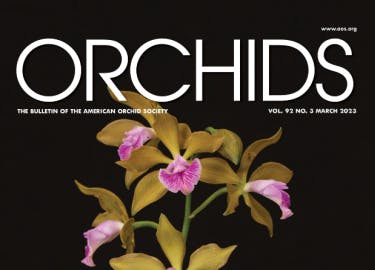
Most orchid hobbyists have developed innovative methods of potting, hanging and mounting their plants, following the tips and hints of more experienced growers and emulating the real creativity they observe in the exhibits at shows. Enthusiasts are always looking for new ideas to grow their orchids to maximize blooming, as well as displaying them to elicit oohs and ahhs from friends and other society members.
Scott Peplin is an orchid grower from South Florida who also builds structures for housing orchids that he calls “orchid environments.” He cares for and services collections of local clients and conducts classes at his “Orchid Bar and Grill,” the centerpiece for his stunning orchid collection. A whirlwind of a guy who is always “on,” Scott has a knack for devising new ways to grow his glorious plants. His latest and greatest pet project is the “cork coozie” and it is proving to be a wildly successful and easy means to get orchids going and growing (www.Orchidenvironments.com/orchidcoozies)!
[1] Cattleya removed from its clay pot and ready for a coozie.

Those cork slabs for mounting that are fairly easy to come by are also available at many orchid supply companies in tubes of various lengths and diameters and sold by the pound. The small size with diameters of 3–4 inches (7.6–10.2 cm) are better for air plants. The medium or large-diameter tubes are more suitable for growing orchids. Scott takes one of these tubes, typically about 5–8 inches (12.7–20.3 cm) in diameter for a medium coozie, and saws it into sections about 6–8 inches (15.2–20.3 cm) long, depending on what kind of a plant he will be working with. That is about right for a mini-to-medium cattleya or a Brassavola nodosa.
[2] Prepared plant is simply slipped into an appropriate size cork tube.

Then he drills four holes a few inches apart and bends the prongs of a wire hanger into each hole about an inch (about 2.5 cm). If the coozie has a vertical split, he uses a snap tie to secure it.
He might loosely encase the bare roots of the plant in coconut coir or he just plops it right into the cork container making sure it does not slip through. He secures the plant tag onto the wire and then he is ready to hang it in a spot with conditions conducive to growing that type of orchid. Voila! Orchids grown in cork coozies tend to do better hanging rather than on a bench because the roots seem to thrive with more air movement.
The coconut husk is entirely optional — bare root is fine too. If you create a coozie while your orchid is in active growth, in a matter of days, the roots will grow and adhere to the interior of the coozie and continue to happily spread all around it. Even though the orchids growing in this type of environment are essentially bare root they may not necessarily require more frequent watering than plants growing in a medium because the cork does retain some moisture. They should be fertilized like other potted or mounted plants.
[3] ”Coozied” plant ready for hanging.

Sometimes Scott will be able to get some rather large tubes and he fondly refers to these as “pony kegs” or “keggers,” depending on the size. These are ideal for larger orchids or plants that have simply outgrown their current habitat, and they are constructed using the same method as the smaller coozies. The size of the coozie will depend on the size of the root system of your plant.
Orchids that seem to thrive in cork coozies are cattleyas, Brassavola nodosa and its hybrids, laelias, oncidiums and catasetums. Small dendrobiums will do well in little coozies because they like being tightly packed. The larger ones tend to be too top-heavy for the coozie environment.
[4] For plants that are too big for a natural tube, pieces of cork can be assembled and held together with plastic zip ties.

Cork bark appeals to orchid growers because it is a natural product, stripped from cork trees at optimal times so as not to damage the trees and allowing new bark to grow in its place. No trees are destroyed and there is no disturbance to flora or fauna.
[5–6] ”Coozied” plants take advantage of air movement and light when hung.

When used as a planter for orchids, there is resistance to mold and fungal growth. Coozies last for many years, they withstand all weather and are a 100 percent sustainable material. Cork coozies are easy to maintain, with no repotting required and they are quite attractive, especially when festooned with moss or viny foliage. What a concept!

— Jill Smith started her orchid journey in 2005 when she tried to save her fatherin-law’s collection after he had passed away. To learn more, she joined the Houston Orchid Society and eventually became a board member. An avid orchid hobbyist, she relocated to Fort Lauderdale in 2009 and joined the Fort Lauderdale Orchid Society where she currently serves on their board. Most notably, she started the Keiki Club for new members of the society and she and her cochairs are devoted to helping them discover the joy and beauty in raising orchids (email jsmith8146@comcast.net).











